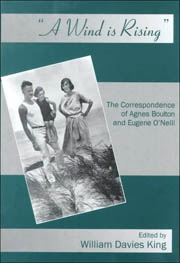![]()
 |
"A Wind is Rising"
The
Correspondence of Agnes
William Davies King |
Forty-six of Eugene O'Neill's letters to his wife Agnes Boulton have already been published in The Selected Letters of Eugene O Neill, edited by Travis Bogard and Jackson Bryer in 1988. But this correspondence between Boulton and O'Neill sheds new light on a key period in O'Neill's life. It may even be a prelude to a biography of Boulton, “a first effort,” hints the book's editor, William Davies King, to return to the subject of a woman whose work “will never figure in any canon”, but whose words “deserve close attention.” Indeed, if O'Neill's letters constantly reveal his verbal acumen, it is Boulton who emerges as the more sympathetic “character” in what often reads like an epistolary novel or script. Part of the interest of the correspondence has little to do with the fact that O'Neill and Boulton are well-known figures. It reads so like a sardonic account of disintegrating love that it almost feels “plotted” to that end. Reviewed as such, it would be open to charges of gender stereotyping. The man starts by profusely declaring devotion, and ends full of self-justification about why he has found someone else. The woman is left looking after the children and seeking a new life encouraged by an ex-husband who urges her to “be happy!” and exclaims his “deepest friendship always, dear!” The fact that the man was a famous playwright and the woman a pulp fiction writer leaves the plot looking all the more hackneyed. But King's admirable commentary prompts us to realize that, on some level, O'Neill and Boulton actually were acting out parts. “Love is a story,” asserts Yale psychologist Robert J. Sternberg in a 1998 book of that name. Boulton and O'Neill's correspondence provides exemplary proof of the accuracy of Sternberg's thesis. As for A Wind is Rising as a piece of literary marginalia, the correspondence covers 1918 to 1928, years that included the death of O'Neill's father (1920), mother (1922), and brother James (1923), and O'Neill's final success in breaking his dependence on alcohol. It also covers years in which the O'Neills lived in half a dozen homes and O'Neill himself in numerous hotels. His plays of the period reflect this lifestyle, with settings as diverse as the West Indies, Palestine, China, Florida, and the North Atlantic. This is also the decade in which O'Neill started to face public scrutiny and media gossip. “Long before the explicitly autobiographical plays of his late career,” notes King, “journalists detected signs that this writer saw drama as a form of self-exploration.” But even as literary marginalia, the chief interest is the presence of Boulton's voice as O'Neill's interactive audience, “her struggle, as it were, to remain on the same page with her husband.” Her words, suggests King, seem as if “married to his words, and tell something about the way words bond, the way fictions are created, the way communication breaks down.” A single mother writing for a living before the marriage, Boulton published her first story as a teenager and retained as her major subject “the constantly shifting relation of power between men and women, especially within marriage.” King's sympathies may be reflected in his choice of title. A Wind is Rising was the name of an unpublished novel Boulton circulated in the early 1940s. In 1959 she published Part of a Long Story, the first in a projected trilogy about her life with O'Neill. The third, covering 1923 to 1928, would have been called by the title of that 1940s novel. “Le vent se leve,” wrote Paul Valery, “il faut tenter de vivre” (The wind is rising, we must attempt to live). And the wind did indeed rise. A relationship that began with declarations of unending devotion turned within ten years into a storm of accusations and eventual divorce. The surviving correspondence is lopsided. The first half of the book, covering January to March 1920, is an intense dialogue of about a hundred letters, often as many as three in a day. But the latter part of the book is mostly O'Neill. Few of Boulton's letters remain from the time of the marriage break-up. Much of what we get is an O'Neill monologue on his new romance with his eventual second wife, Carlotta Monterey. His final words to Agnes are pleasantries on a postcard from Bermuda depicting the tomb of a woman named Agnes Sorel. It is almost too appropriate, as if the correspondents have colluded to ensure that if the marriage goes wrong at least the plot comes out right. “In truth,” writes King, O'Neill “saw his own life as an enormously complex drama. During the years 1918 to 1929 a leading character in that drama was his wife, Agnes Boulton.” That about sums up the man who comes across in this correspondence. “What has happened is neither your fault nor mine,” O'Neill writes at one point. “It is simply the curse of the soul's solitude, the grinding, disintegrating pressure of time, that has destroyed us.” Such rationalizing hardly needs a gloss, but while we hear Agnes less and less often, what she does say seems all the more accurate. In one letter, for instance, she tells him that his many explanations “are obviously an attempt at justification of what you are doing.” Moreover, maybe in the end Agnes does get, if not the last, then the most pertinent word. “When I think of Shane and Oona I suffer like hell from a sense of guilt toward them,” writes O'Neill in a typical late letter, “and a deep sense of guilt because I've made you suffer.” King informs us that beside this comment someone has written the word “Puke.” It is likely that the handwriting belongs to Agnes, and that she has managed to stay on the same page as her husband after all.—Gavin Cologne-Brookes, Bath Spa University College |
|
© Copyright 1999-2007 eOneill.com |